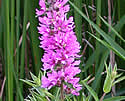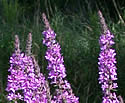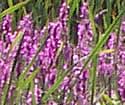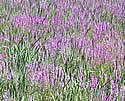Lythrum salicaria (Purple Loosestrife)
| Also known as: | |
|---|---|
| Genus: | Lythrum |
| Family: | Lythraceae (Loosestrife) |
| Life cycle: | perennial |
| Origin: | Eurasia |
| Status: |
|
| Habitat: | sun; moist soil; along shores, marshes, wet ditches, wet meadows, floating mats |
| Bloom season: | July - September |
| Plant height: | 2 to 6 feet |
| Wetland Indicator Status: | GP: OBL MW: OBL NCNE: OBL |
| MN county distribution (click map to enlarge): |  |
| National distribution (click map to enlarge): |  |
Pick an image for a larger view. See the glossary for icon descriptions.
Detailed Information
Flower: 

![[photo of flowers]](/udata/r9ndp23q/purple/purple-loosestrife-0804_115254-t.jpg) Flowers are in a spike up to 20 inches long, densely packed with purple or pinkish-purple flowers. Individual flowers are ½ to ¾ inch across, have 5 to 7 petals (6 is most common), about 10 purple-tipped stamens. The petals have pointed or slightly rounded tips, a dark vein down the middle, and a wrinkled texture like crumpled tissue paper. The tubular calyx holding the flower is yellowish green, ridged, hairy, and has several long prong-like appendages at the tip end. One plant has numerous spikes.
Flowers are in a spike up to 20 inches long, densely packed with purple or pinkish-purple flowers. Individual flowers are ½ to ¾ inch across, have 5 to 7 petals (6 is most common), about 10 purple-tipped stamens. The petals have pointed or slightly rounded tips, a dark vein down the middle, and a wrinkled texture like crumpled tissue paper. The tubular calyx holding the flower is yellowish green, ridged, hairy, and has several long prong-like appendages at the tip end. One plant has numerous spikes.
Leaves and stem: 


![[photo of leaves]](/udata/r9ndp23q/purple/lythrum-salicaria-purple-loosestrife-100_1769-t.jpg) Leaves are up to 4 inches long and 1 inch wide, toothless, gradually tapering to a pointed tip, with a rounded or heart-shaped base and no leaf stalk. Attachment is opposite, or occasionally in whorls of 3 or 4. The stem is square and covered in downy hair. Established plants can have dozens of shoots and take on a bushy appearance.
Leaves are up to 4 inches long and 1 inch wide, toothless, gradually tapering to a pointed tip, with a rounded or heart-shaped base and no leaf stalk. Attachment is opposite, or occasionally in whorls of 3 or 4. The stem is square and covered in downy hair. Established plants can have dozens of shoots and take on a bushy appearance.
Fruit: 
![[photo of fruit]](/udata/r9ndp23q/purple/purple-loosestrife-100_5412-t.jpg) The calyx becomes a receptacle for the seed, and turns purplish as it ripens, then drying to brown. A single mature plant can produce well over a million seeds a year.
The calyx becomes a receptacle for the seed, and turns purplish as it ripens, then drying to brown. A single mature plant can produce well over a million seeds a year.
Notes:
Purple Loosestrife is on the prohibited weed list for Minnesota. It was introduced to the US in the garden trade, quickly escaped cultivation and has been ravaging wetland habitats ever since. It even volunteered in my suburban garden once! It is exceedingly aggressive and can overtake native plants very quickly. The current Minnesota county distribution map doesn't really reflect how widespread this species is in the state; according to EDDMapS, it's currently unreported in only a few western counties, but chances are it is somewhere in those counties, too.
Purple Loosestrife is one of several invasive species with biocontrols: 3 beetles that feed on leaves, flowers or root systems, all of which can impede seed production. The hope of biocontrols may be eradication, but the more realistic goal is to significantly reduce populations and subsequently reduce the impact on native wetland flora and fauna.
Purple Loosestrife is sometimes mistaken for Fireweed (Chamerian angustifolium), which has 4 broad paddle-shaped petals and alternate leaves.
Native Plant Nurseries, Restoration and Landscaping Services ↓
More photos
 Purple Loosestrife plant
Purple Loosestrife plant a bushy Purple Loosestrife plant
a bushy Purple Loosestrife plant more flowers
more flowers a small infestation of Purple Loosestrife
a small infestation of Purple Loosestrife a larger infestation of Purple Loosestrife
a larger infestation of Purple Loosestrife infestation along a lake shore
infestation along a lake shore biocontrol Galeracella weevil on Purple Loosestrife
biocontrol Galeracella weevil on Purple Loosestrife fruits persist through winter
fruits persist through winter
Photos by K. Chayka and Peter M. Dziuk taken at various locations in Anoka and Ramsey counties.
Comments
Have you seen this plant in Minnesota, or have any other comments about it?
on: 2010-05-21 10:32:36
This plant happens to be all over the mississippi downtown as well. Boom Island to St.Anthony falls. I try to pull it out when I can but the roots are quite stubborn.
on: 2010-08-07 09:55:51
There are colonies of them growing in the swampy areas in Southern Crow Wing and Northern Morrison Counties. They are beautiful. Too bad they are considered a noxious weed.
on: 2011-06-08 07:31:58
This plant is in my flower bed and I cannot rid myself of it. I have literally removed all wanted perrenials and taken out multitudes of feelers of this plant and it continues to return. What can I do????
on: 2011-06-08 16:58:11
I'm not an expert on this particular subject but the DNR does have a web page on this plant at their web site.
You can also contact your county Soil and Water Conservation District and see if they can give you some assistance. Please also see the links from my invasive species page. Good luck with it
on: 2012-08-21 13:49:28
They weren't in the ditch this spring but now everywhere
on: 2016-10-29 16:10:42
If you live in MN it's possible to get some help from an insect that eats it. Details here: http://www.dnr.state.mn.us/invasives/aquaticplants/purpleloosestrife/biocontrol.html
on: 2017-03-16 00:21:12
I have had one in the garden, in the same spot since 1964. Never spread, never gets invasive in yard. It is usually the prettiest of all my flower and it flowers from June to August. I just can't bring myself to destroy what has turned out to be one of my favorite plants of all time in my yard. It is indestructible, it has been run over, mowed over, survived -35F, survived drought, grasshoppers, deer, name it. It will likely outlive me which will make me happy.
on: 2019-08-27 14:33:50
Quite a bit of purple loosestrife in Upper Gull Lake. Great pictures for comparison on the native winged and swamp loosestrife.
on: 2020-09-07 15:06:35
Found my first multistemmed plant on my property. Took it out. Sure, it was good looking. Added color where there was none but not something I want to play with.
on: 2021-06-27 14:06:07
Gone. The pond/swamp along highway 7 was a purple blanket for many summers. Then it was everywhere one looked. But the last few summers I haven't seen any! Maybe the invading carp eat it!
on: 2021-07-21 13:26:05
Sadly, I was surprised to see this in the Quaking Bog right along the boardwalk and hope folks are working to eradicate this. The bog is such a wonderful and unique ecosystem, I'd had to see this species take over.
on: 2021-07-30 19:58:09
Joe S. if you have had one in your yard since 1964 and it has not spread, it is not purple loosestrife. Possibly it is native Showy Tick Trefoil.
on: 2021-08-18 13:41:46
I saw a couple of colonies of it today, at the edges of swamps in the Sherburne National Wildlife Refuge, along the Mahnomen Trail. Most unfortunate.
on: 2021-08-18 16:14:00
I've been seeing it in wet ditches and cattail marshes all over Minnesota this year. Sad.
on: 2022-08-30 22:26:54
Purple Loosestrife is starting to form large colonies in the Palmer Lake Environmental Nature Area in Brooklyn Center... but that whole area is overrun with invasive species. Really disheartening to see considering it is supposed to be a nature preserve.
on: 2022-09-13 08:24:57
There is a small pond nearby with a large infestation of these. It's slightly west of the corner of Silver lake road and the county road that goes by sunnyside elementary school. (Can't remember what the name of the country road is right now, sorry.) The whole thing is purple.
on: 2023-07-14 16:55:34
Suddenly seeing it on my lakeshore at Lake Alimagnet in Burnsville. Never seen it before in the 20+ years I've been here.






